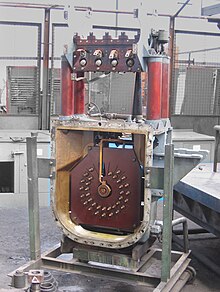Step switch
A step switch is an electrical switch with several switch positions, which connects one connection to another connection, which is selected by the switch position from a group of several connections. Typical applications are the regulation of voltages or the selection of a signal. Simple electric vehicles and older electric locomotives use step switches to regulate the pulling force.
Types and structure
Step switches are designed as rotary switches or as flat track switches. It is driven either by hand, by electric motors or air motors .
You can have one or more switching levels that are operated by the same actuating element. Each switching level has a separate connection that can be connected to its own selection of connections. With some types, the number of switch positions can be configured during assembly.
The switch contacts are in switching by cam operated on a shift drum or they slide on each other. For larger outputs, the tap changers are often insulated with oil in order to prevent arcing from occurring. Tap changers of transformers are mostly integrated into their insulating oil circuit.
Step switches are also differentiated according to how the switching process between two connections takes place: With Break Before Make or abbreviated BBM , the connection to the old connection is interrupted before the connection to the next connection is established, with Make Before Break or MBB for short, the old and the old connection are briefly used new connection connected to each other. With some switches, an isolating stage is briefly switched between two adjacent stages.
Step switches for large capacities have load switch contacts that are separate from the contacts for selecting the desired step. In this way, the switching of the power can be concentrated on a few contacts that are made of erosion-resistant contact materials and are provided with spark chimneys to extinguish the switching arcs . Copper or brass are usually used as contact materials.
Step switches for small signal applications require particularly corrosion-resistant contact materials, often also with low contact resistance. They are usually made of gold or palladium , with somewhat larger currents also of silver . Other contact materials are only suitable in gas-tight encapsulated switches, where they are protected from environmental influences. Contacts sliding on each other can clean themselves under suitable conditions.
application
Telephony
Before the introduction of digital switching technology , step switches were used as rotary selectors and call finders in the switching centers.
Voltage and power control
power grid
In the power grid , step switches are used to regulate the line voltage of power transformers in the event of load changes. The switches can only regulate the voltage in a small range and can not replace grid control by adapting the power of the power plants to current consumption. The switches are built into the housing of the power transformer and are isolated from the transformer's oil.
Electric vehicles

Before power electronics were used, step switches were the only way to regulate the voltage at the drive motor connections. In AC vehicles, the tap changer had the task of connecting the various transformer taps with the traction motors; in DC vehicles it was the steps of the series resistor.
Usually a transformer with several secondary taps is used for this. The exact functional principle is described in the article Step switch for power transformers . Instead of a tap changer, a sliding transformer can also be used to achieve the desired voltage change. However, this is more prone to failure and, due to its construction, cannot be used for very high outputs.
Depending on the design, the step switches are given special names:
- Flat track step switch , also slide step switch
- Cam roller step switch
- Hopper control , with multiple electropneumatic contactors (also called hopper ), often used in DC vehicles
- High-voltage tap changers, which are arranged on the primary side of the transformer.
Depending on the type of operation, a distinction is also made between direct and indirect step switches. With the direct step switch, the step is set immediately. With the indirect, an electrical control takes over the connection. The desired level is only specified and optimized by the controller, for example when the current has fallen below a certain value. In newer vehicles, almost only indirect step switches are installed.
With electric drives today, step switches are usually not used at all. Instead, the drive is controlled with power electronics.
Other applications
In everyday life, the best-known power level switches are likely to be the rotary switches on an electric hob , which controls the cooking levels by switching on and grouping the heating elements.
Single-phase switches are used on variable transformers . For small outputs of up to a few kilowatts, the switches are often built with a grinder that directly brushes the bare winding wires as connections. This type of construction is also known as a sliding transformer.

